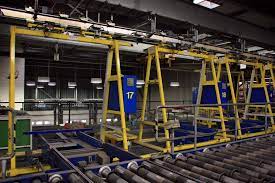
Conveyor belts are the backbone of many industrial operations, ensuring the smooth and efficient movement of materials. To keep your conveyor belts running at peak performance, follow these essential tips.
1. Regular Inspections
Conduct regular inspections to identify signs of wear and tear, misalignment, or damage. Look for frayed edges, unusual noises, and uneven wear patterns. Early detection of issues can prevent costly downtime and extend the life of your conveyor belts.
2. Proper Tensioning
Ensure your conveyor belts have the correct tension. Over-tensioning can cause excessive wear on bearings and pulleys, while under-tensioning can lead to slippage and inefficient operation. Use a tension meter to achieve the ideal tension for your specific belt.
3. Cleanliness
Keep your conveyor belts clean to prevent the build-up of debris that can cause damage and reduce efficiency. Implement a regular cleaning schedule and use appropriate cleaning agents. Avoid harsh chemicals that can degrade the belt material.
4. Professional Maintenance
Engage a professional for periodic maintenance. Professionals have the expertise to perform detailed inspections, adjustments, and repairs that can significantly improve the performance and longevity of your conveyor belts. Regular professional maintenance ensures your belts operate smoothly and efficiently.
Positive Drive Conveyor Belts: Enhancing Performance
Positive drive conveyor belts offer superior performance in applications requiring precise product handling and minimal slippage. Here’s how to get the most out of your positive drive conveyor belts.
1. Understand Your Application
Choose the right positive drive belt for your specific application. Consider factors like load capacity, speed, temperature, and environmental conditions. Consult with a professional to select a belt that meets your operational requirements.
2. Proper Installation
Ensure correct installation of your positive drive belts. Follow manufacturer guidelines and use proper tools and techniques. Misaligned or improperly installed belts can lead to premature wear and operational inefficiencies.
3. Regular Lubrication
Lubricate your positive drive belts regularly to reduce friction and wear. Use lubricants recommended by the belt manufacturer to avoid compatibility issues. Regular lubrication can enhance the performance and extend the life of your belts.
4. Monitoring and Adjustments
Continuously monitor the performance of your positive drive belts and make necessary adjustments. Keep an eye on belt tension, alignment, and overall condition. Timely adjustments can prevent minor issues from becoming major problems.
5. Professional Expertise
Rely on professionals for installation and maintenance of positive drive belts. Their expertise ensures optimal performance and helps avoid common pitfalls. Professionals can provide valuable insights and recommendations tailored to your specific needs.
Power Transmission: Ensuring Reliable Operations

Effective power transmission is crucial for the smooth operation of industrial machinery. Here are some tips to ensure reliable power transmission in your facility.
1. Select the Right Components
Choose the right power transmission components for your machinery. Consider factors like load requirements, speed, and environmental conditions. Consult with a professional to ensure you select components that meet your operational needs.
2. Regular Maintenance
Perform regular maintenance on your power transmission system. Inspect belts, chains, gears, and couplings for signs of wear and damage. Lubricate moving parts regularly to reduce friction and prevent premature wear.
3. Alignment and Tensioning
Ensure proper alignment and tensioning of belts and chains. Misalignment can cause excessive wear and reduce efficiency. Use alignment tools and tension meters to achieve precise adjustments. Regular checks and adjustments can significantly enhance the performance and lifespan of your power transmission system.
4. Professional Assistance
Engage a professional for installation and maintenance of your power transmission system. Professionals have the expertise to ensure proper setup and optimal performance. They can identify potential issues early and provide solutions to maintain reliable operations.
Industrial Supplies: Streamlining Your Operations
Industrial supplies play a crucial role in the efficiency and productivity of your operations. Here’s how to manage your industrial supplies effectively.
1. Inventory Management
Implement an efficient inventory management system to keep track of your industrial supplies. Use software solutions to monitor stock levels, track usage, and automate reordering. Proper inventory management ensures you have the right supplies when you need them, reducing downtime and operational disruptions.
2. Quality Control
Ensure the quality of your industrial supplies. Use reliable suppliers and conduct regular quality checks. High-quality supplies reduce the risk of equipment failure and improve the overall efficiency of your operations.
3. Storage Solutions
Organize and store your industrial supplies properly. Use shelving, bins, and labelling systems to keep supplies easily accessible and organized. Proper storage solutions can prevent damage, reduce waste, and streamline your operations.
4. Professional Procurement
Consult with professionals for procurement of industrial supplies. They can provide insights into the best products and suppliers for your specific needs. Professional procurement ensures you get high-quality supplies at competitive prices.
Bearings: Maintaining Peak Performance
Bearings are critical components in many industrial machines, and their performance directly impacts the efficiency and reliability of your operations. Follow these tips to maintain your bearings at peak performance.
1. Proper Installation
Ensure proper installation of bearings to prevent premature failure. Use the right tools and techniques to avoid damaging the bearing during installation. Follow manufacturer guidelines for best results.
2. Regular Lubrication
Lubricate bearings regularly to reduce friction and wear. Use the right type of lubricant for your specific bearings and operating conditions. Regular lubrication can significantly extend the life of your bearings.
3. Monitoring Condition
Monitor the condition of your bearings regularly. Look for signs of wear, overheating, or unusual noises. Early detection of issues allows for timely maintenance and prevents costly breakdowns.
4. Professional Maintenance
Engage professionals for bearing maintenance and replacement. Professionals have the expertise to perform detailed inspections, lubrication, and replacements, ensuring optimal performance and longevity of your bearings. Their expertise can help you avoid common issues and maintain reliable operations.
Keeping Your Operations Running Smoothly
Ensuring your industrial MRO needs are met involves regular maintenance, proper installation, and the use of high-quality components. Whether you are dealing with conveyor belts, positive drive belts, power transmission systems, industrial supplies, or bearings, following these actionable tips can help you maintain efficient and reliable operations. Don’t hesitate to seek professional assistance to optimize your MRO processes and keep your operations running smoothly.
